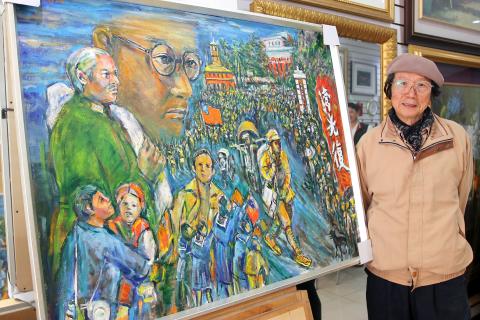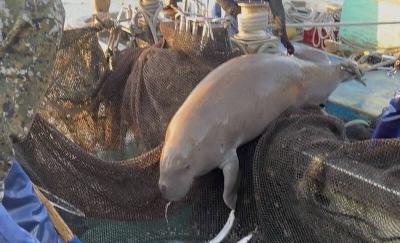While it has become customary for the government to hold a memorial each year to commemorate the victims of the 228 Massacre, not very many young people know what happened in the incident that inspired Taiwan’s democratic movement.
Determined to change that, 79-year-old painter Tung Jih-fu (董日福), who witnessed the bloody crackdown, decided to use the incident as an inspiration for his work and display his paintings this year to mark the 67th anniversary of the incident.
The 228 Incident refers to an uprising that erupted after a Taiwanese woman was beaten by Monopoly Bureau agents on Feb. 27, 1947, for selling contraband cigarettes in Taipei.

Photo: Huang Wen-huang, Taipei Times
The ensuing revolt led to the slaughter of tens of thousands of Taiwanese at the hands of Chinese Nationalist Party (KMT) troops.
Born in what was then Tainan in 1935, Tung lost both her parents in World War II and made a living shining shoes on the street.
Her uncle’s efforts to get him a job painting movie billboards at the now-demolished Yanping Theater in Tainan allowed him to discover his talent. After he served his mandatory military service, he became an apprentice to painter Kuo Po-chuan (郭柏川).
Tung also worked as a teaching assistant in Kuo’s studio, demonstrating basic sketching techniques to beginning students, an experience that later helped him secure a teaching position at National Cheng Kung University and National Taiwan University of Arts.
He is also renowned for his calligraphy, having won several accolades in national calligraphy competitions.
Most of Tung’s oil paintings have been well-received by critics, including the 12 that he exhibited in December 2012 depicting the various cultures of the 78 nations that he has visited.
However, he said his one regret was that he had never immortalized the KMT regime’s takeover of Taiwan in 1945 and the 228 Incident in his work.
Tung said he saw first-hand how the KMT government’s “habit of corruption” triggered the soaring inflation that eventually culminated in the Incident.
“The images of Mainlanders and native Taiwanese fighting on the streets of the capital’s Zhongzheng District (中正), of KMT troops brutally slaughtering innocent people and lawyer Tang Te-chang (湯德章) being executed in what was then Minsheng Park are still vivid in my mind,” Tung said.
Tang was a Japanese-Taiwanese lawyer working in Tainan when the KMT army arrested him on charges of sedition. He was severely beaten before being executed on March 13, 1947, in the park, which was renamed the Tang Te-chang Memorial Park in 1998 in his honor.
Tung’s bid to depict these events received support from Flomo Education Foundation founder Shen Kun-chao (沈坤照), who provided financial assistance to help the artist bring the works to life.
Inspired, Tung produced six paintings in one year: Soldiers with Straw Sandals (草鞋軍隊), An Era of Famine (糧荒時代), A Real Nightmare (真實噩夢), With My Own Eyes (親眼目睹), Inflamed With Anger (滿腔怒火) and A Historical Scar (歷史傷痕).
The painter said he hoped the contrasting colors of his works could remind people of the nation’s gruesome past, while at the same time encouraging the younger generation to respect their history.

‘DENIAL DEFENSE’: The US would increase its military presence with uncrewed ships, and submarines, while boosting defense in the Indo-Pacific, a Pete Hegseth memo said The US is reorienting its military strategy to focus primarily on deterring a potential Chinese invasion of Taiwan, a memo signed by US Secretary of Defense Pete Hegseth showed. The memo also called on Taiwan to increase its defense spending. The document, known as the “Interim National Defense Strategic Guidance,” was distributed this month and detailed the national defense plans of US President Donald Trump’s administration, an article in the Washington Post said on Saturday. It outlines how the US can prepare for a potential war with China and defend itself from threats in the “near abroad,” including Greenland and the Panama

A wild live dugong was found in Taiwan for the first time in 88 years, after it was accidentally caught by a fisher’s net on Tuesday in Yilan County’s Fenniaolin (粉鳥林). This is the first sighting of the species in Taiwan since 1937, having already been considered “extinct” in the country and considered as “vulnerable” by the International Union for Conservation of Nature. A fisher surnamed Chen (陳) went to Fenniaolin to collect the fish in his netting, but instead caught a 3m long, 500kg dugong. The fisher released the animal back into the wild, not realizing it was an endangered species at

The High Prosecutors’ Office yesterday withdrew an appeal against the acquittal of a former bank manager 22 years after his death, marking Taiwan’s first instance of prosecutors rendering posthumous justice to a wrongfully convicted defendant. Chu Ching-en (諸慶恩) — formerly a manager at the Taipei branch of BNP Paribas — was in 1999 accused by Weng Mao-chung (翁茂鍾), then-president of Chia Her Industrial Co, of forging a request for a fixed deposit of US$10 million by I-Hwa Industrial Co, a subsidiary of Chia Her, which was used as collateral. Chu was ruled not guilty in the first trial, but was found guilty

The Chinese Nationalist Party (KMT) is maintaining close ties with Beijing, the Democratic Progressive Party (DPP) said yesterday, hours after a new round of Chinese military drills in the Taiwan Strait began. Political parties in a democracy have a responsibility to be loyal to the nation and defend its sovereignty, DPP spokesman Justin Wu (吳崢) told a news conference in Taipei. His comments came hours after Beijing announced via Chinese state media that the Chinese People’s Liberation Army’s Eastern Theater Command was holding large-scale drills simulating a multi-pronged attack on Taiwan. Contrary to the KMT’s claims that it is staunchly anti-communist, KMT Deputy